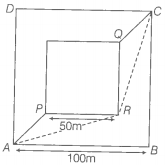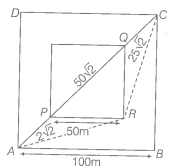4.37. A man wants to reach from A to the opposite comer of the square C. The sides of the square are 100 m. A central square of 50 m × 50 m is filled with sand. Outside this square, he can walk at a speed of 1 m/s. In the central square, he walks only at a speed of v m/s. What is the smallest value of v for which he can reach faster via a straight path through the sand than any path in the square outside the sand?

Consider adjacent diagram,

Time is taken to go from A to C via straight-line path APOC through the sand
Step 2: Find the time taken to go through the path outside of the sand.
Clearly from the figure, the shortest path outside the sand will be ARC.
Time is taken to go from A to C via this path
Step 3: Find the minimum value of v

© 2025 GoodEd Technologies Pvt. Ltd.